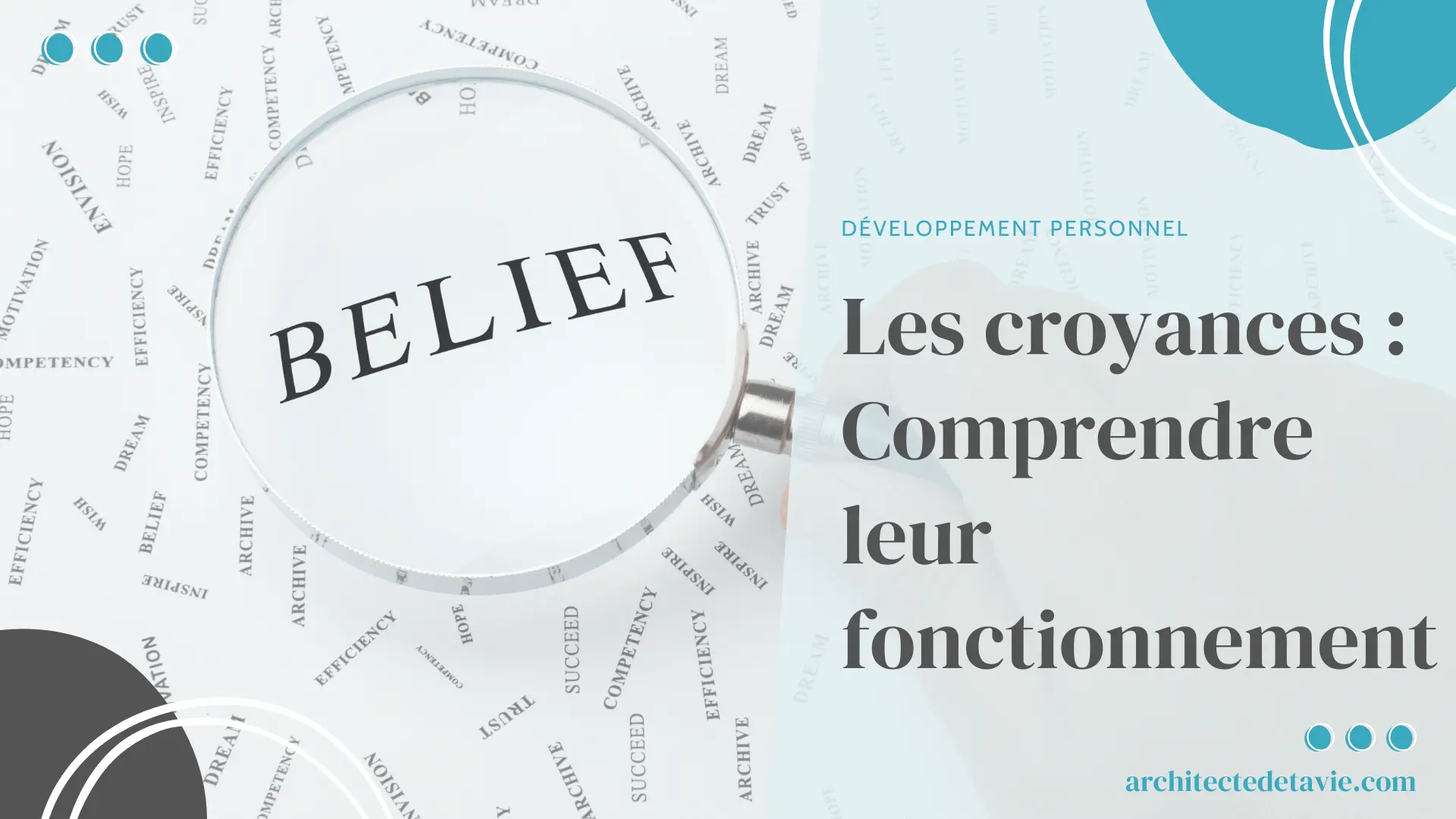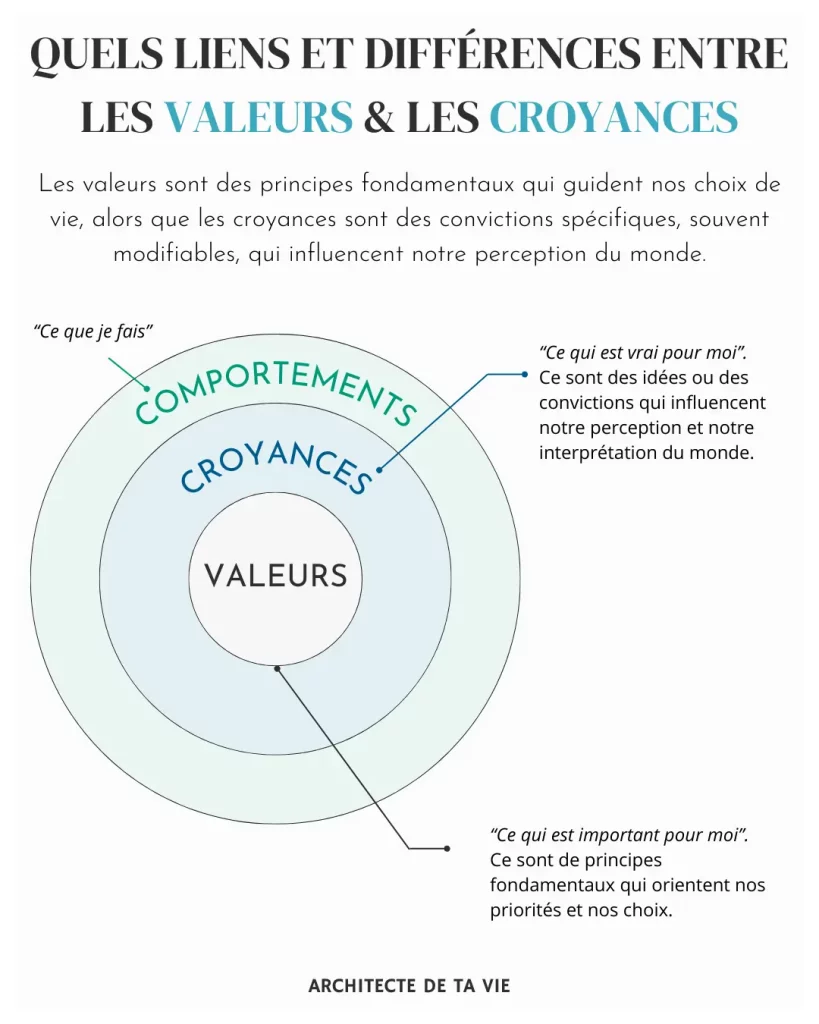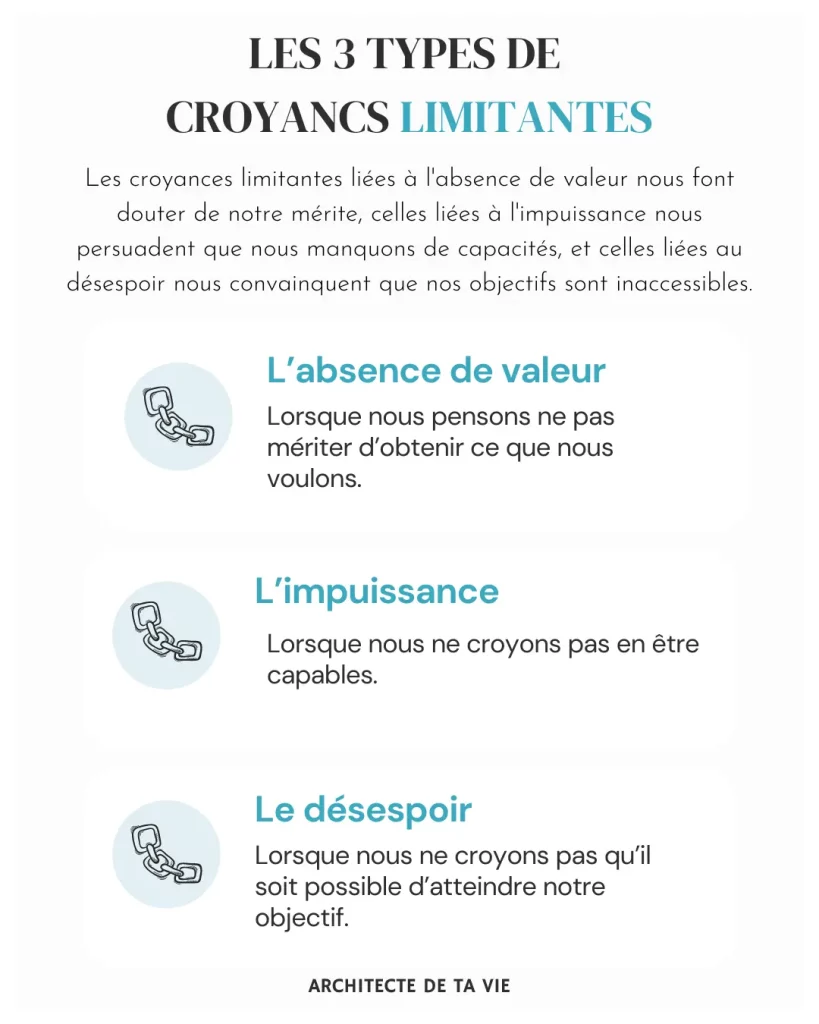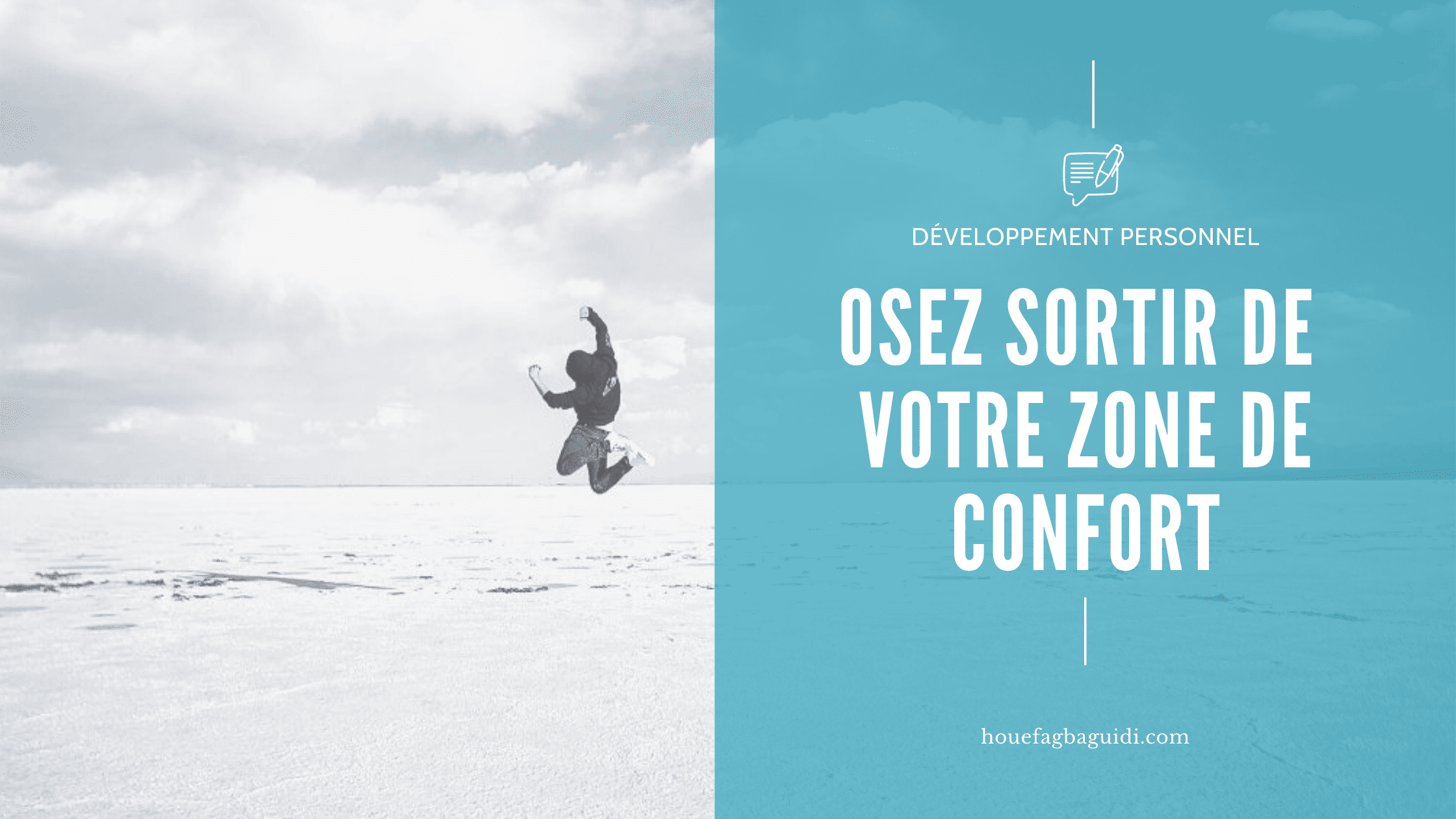
Beliefs: Understanding how they work to transform your mindset
Dernière mise à jour de l'article le 17 October 2024
Welcome to this blog, designed to help you take control of your life and become the architect of your own destiny!
Are you wondering what truly motivates you on a daily basis? Would you like to discover that spark that makes you excited to get up every morning?
✨ Why not start with an online test to identify your core values? Take the first step towards a more aligned life by clicking here: Identify Your Core Values.
Introduction
Do you know what limiting beliefs are?
You may have come across this term while reading a personal development book.
Limiting beliefs are negative internal thoughts that can hold us back and prevent us from achieving what’s important to us. They are ideas that are ingrained in us, generally stemming from our past experiences, and which shape the way we see the world and the way we behave. They can take the form of doubts, fears or deep-seated convictions.
That’s right!
As you can see, these beliefs can be (very) problematic both personally and professionally. And if we don’t become aware of these beliefs, we can remain trapped in our doubts and fears and continue ourself-sabotaging behaviour.
That’s why I’d like to take you on a tour of this universe!
This article will help you explore what beliefs are, how they are formed and, above all, how you can identify and reprogram them if they prove to be limiting.
By becoming aware of these mental blocks, you’ll see that they can be transformed into opportunities for development!
Let’s get started! Let’s get started!
What is a belief?
Before taking a tour of the world of limiting beliefs, let’s go up a level and look at what a belief is.
A belief is a conviction that we hold to be true or probable. It may be based on personal experience, cultural traditions, teachings received, family or social influences, or personal intuition.
Beliefs can be rational, based on evidence and logical reasoning, or irrational, based on feelings, superstitions or unverified information.
These beliefs shape our view of the world, influence our behaviour and determine how we interact with our environment. They act as filters through which we interpret every situation, every relationship and every opportunity.
Beliefs form part of our identity and will influence our perception of reality.
In fact, we could confuse beliefs with values, but they’re not quite the same thing:
- Beliefs allow us to explain and interpret the world around us, influencing the way we perceive situations and events.
- Values provide a compass that guides our choices and actions, dictating what we consider to be good, right and desirable.


If you’d like to find out more about personal values, read this blog post which explains what our values are and how we can identify them: Values: a journey of self-discovery.
How is a belief formed?
What are the origins of our beliefs?
Our beliefs have their roots in the earliest moments of our existence, in childhood.
They are forged through the education we receive, our personal experiences and the social influences that surround us. As we grow up, the messages conveyed by our parents, teachers and loved ones play a decisive role in shaping our beliefs.
For example, if a child constantly hears that he is intelligent and capable, he will develop a positive belief in his abilities. Conversely, repeated negative remarks or criticism can anchor limiting beliefs. For parents: be careful how you talk to your children, as this will have an impact on their future.
Our social interactions, cultural norms and the values shared in our environment also help to shape our perception of the world and of ourselves.
How is a belief reinforced?
A belief is not necessarily created in childhood.
Repetition also plays a key role in reinforcing our beliefs. The more an idea or thought is repeated, the more deeply it will become anchored in our minds.
This repetition can come from our inner dialogue or from external interactions. For example, if you regularly hear that you are not good at public speaking, you will end up integrating this belief as an absolute truth. Similarly, repeated experiences, such as successive failures in a particular area, can solidify a limiting belief.
The power of repetition lies in its ability to transform perceptions into perceived realities, thereby influencing our behaviour and choices.
An example to illustrate the creation of beliefs
Imagine an employee in a company who has presented several projects at important meetings, but each time his or her ideas have been rejected or criticised by his or her manager and colleagues. After each failure, this employee will begin to believe that he or she is not competent in project management or innovation, for example.
This belief will gradually develop into a limiting one and will be reinforced with each new unsuccessful attempt, until the employee avoids proposing ideas or taking the initiative altogether.
This belief that they are not up to the job will lead them to withdraw from important discussions, to stop expressing their opinions, and to turn down opportunities that could put them ahead.
Over time, this attitude can have a negative impact on his career, limiting his prospects for promotion and professional development, while affecting his self-esteem and job satisfaction.
If we are not careful, this type of belief, forged by specific experiences, can have a significant impact on our perception of our own skills and on our future actions in the professional context.
What is the difference between helping and limiting beliefs?
Beliefs fall into two main categories: helping beliefs and limiting beliefs. Yes, beliefs are not always negative!

Supporting beliefs are those that propel us forward, motivate us and boost our self-confidence. For example, believing in our ability to succeed in an ambitious project can encourage us to invest time and effort in achieving it.
Conversely, limiting beliefs hold us back and prevent us from reaching our full potential. These are negative or restrictive thoughts, such as « I’m not competent enough » or « I’ll never succeed », which lead to feelings of doubt and fear.
The distinction between these two types of belief will determine whether our thoughts encourage us to move forward or keep us stuck.

Whether you think you can or you think you can’t, either way you’re right.
– Henry Ford
There are 3 types of limiting beliefs:
- The absence of value, when we think we don’t deserve to get what we want. “I’m an impostor…”. These beliefs often manifest themselves in feelings of lack of worth, low self-esteem or constant self-doubt. They can prevent us from seizing opportunities or recognising our successes. (add link to podcast Unique valeur de soi)
- Powerlessness, when we don’t believe we are capable. “I’m too old…”… These limiting beliefs convince us that we lack the skills, resources or characteristics needed to succeed. They can lead us to give up before even trying, to avoid challenges, or not to persevere in the face of obstacles.
- Despair, when we don’t believe it’s possible to achieve our goal. ” It will never change…”… This type of belief makes us see our dreams and aspirations as unattainable, no matter how hard we try. This can lead to a fatalistic attitude in which we give up, convinced that any attempt will be in vain.

Some examples of limiting beliefs
- Beliefs about oneself: “I’m not good enough”, “I don’t deserve success”.
- Beliefs about others: “People are selfish”, “You can’t trust anyone”.
- Beliefs about the world: “Life is hard”, “You have to work hard to succeed”.
- Concrete examples: Tell anecdotes or case studies to make the examples more tangible.
To discover other limiting beliefs, I invite you to take a look at episode #44 of the Quart d’Heure d’Inspir’Action podcast: 9 beliefs that prevent you from living your life.
Drivers, beliefs stemming from social injunctions
Drivers, or social injunctions, are deeply rooted beliefs that influence our everyday behaviour and decisions. They are often developed during childhood and can act as driving forces in our adult lives, or on the contrary, become obstacles to our development.
There are five main Drivers: “Be perfect”, “Be strong”, “Make an effort”, “Enjoy yourself” and “Hurry up”. Each of these Drivers pushes us to act in a certain way, often in response to perceived or real expectations from our environment. For example, the “Be perfect” Driver can lead us to set unattainable standards, generating stress and frustration.
To navigate effectively through these Drivers and take advantage of them in a positive way, the first step is to identify them and understand how they influence your life. Take time to reflect on your behaviours and underlying motivations. Then work on balancing them so that they become assets rather than obstacles.
What impact do beliefs have on our daily lives?
I’ve already talked a little about this in previous paragraphs: beliefs have a profound impact on our day-to-day decisions, behaviour and emotions.
A supportive belief can give us the strength to overcome obstacles and seize opportunities, while a limiting belief can paralyse us and prevent us from taking action.
For example, someone who firmly believes in their leadership skills will be more inclined to apply for positions of responsibility and to take the initiative.
Conversely, someone who is convinced that they are not worthy of love or success may sabotage their relationships and ambitions, thus avoiding any situation where they could be faced with failure.
Beliefs influence every aspect of our lives, from career choices to our personal relationships and emotional well-being.
Being aware of these beliefs is therefore an important way of getting to know ourselves better and working to transform those that prevent us from achieving our goals. Being aware of our limiting beliefs can help us create a more fulfilling and balanced life.
Our beliefs act like filters through which we perceive and interpret the world. They directly influence our state of mind and our actions. However, it is important to remember that our beliefs are not fixed and can be modified. By challenging our limiting beliefs and replacing them with positive ones, we can transform our state of mind and bring about real change in our lives.
Our beliefs play a central role in the way we operate.
They influence the way we perceive the world, interpret events and make decisions:
- Perception: They filter and interpret the information we receive. For example, a person who believes that the world is dangerous will perceive more threats in their environment.
- Emotions: These generate emotional responses. A limiting belief can cause anxiety or fear, while a helping belief can generate confidence and motivation.
- Behaviour: They dictate our actions and reactions. For example, if someone believes they are unable to speak in public, they will avoid situations where they have to.
- Communication: They influence the way we communicate. A positive belief about others will encourage open and caring communication.
A few tips for reprogramming your limiting beliefs
Identify and challenge your limiting beliefs
We’ve seen how belief systems influence our state of mind. Now it’s time to learn how to identify and challenge your limiting beliefs. Often deeply rooted, these beliefs can hold you back from reaching your full potential.
The first step is to become aware of your limiting beliefs. To do this, pay particular attention to your thoughts, words and actions. Notice the times when you say negative things to yourself like “I’m not good enough” or “I’ll never amount to anything”. These are clear indicators of limiting beliefs.
Once you’ve identified these beliefs, it’s essential to challenge them. Ask yourself whether they are really based on fact or whether they stem from fears or past experiences. Ask yourself questions such as “Does this belief really serve me?” or “What evidence is there against this belief?”
Once you’ve challenged your limiting beliefs, you can start to replace them with positive, constructive beliefs. Use positive affirmations, explore new perspectives and boost your self-esteem.
By transforming your limiting beliefs into positive ones, you’ll change your mindset and open the door to new opportunities.
Transform your mindset with new positive beliefs
Now that you’ve identified and challenged your limiting beliefs, it’s time to replace them with new, positive ones. This transformation process may seem daunting, but it’s an essential step in changing your mindset and opening the door to new opportunities.
One way to change your beliefs is to use positive affirmations. Affirmations are powerful, positive statements that you repeat to yourself regularly. For example, instead of saying “I’m not good enough”, repeat to yourself “I’m competent and I deserve success”.
Another approach is to explore new perspectives. Try to see situations from a different angle and look for evidence that contradicts your old limiting beliefs. You may find that this evidence shows that you are in fact capable of achieving great things.
Finally, boost your self-esteem by surrounding yourself with positive people and situations. Choose people who support and encourage you on your journey of transformation. Get involved in activities that make you feel good about yourself and boost your self-confidence.
Transforming your limiting beliefs into positive ones is an ongoing process. Be patient with yourself and persevere. By developing a positive frame of mind, you will discover new resources and realise your full potential.
The role of practice and perseverance in changing beliefs
Now that you’ve understood the importance of replacing your old limiting beliefs with positive ones, it’s time to talk about the essential role of practice and perseverance in this transformation process.
Changing deeply rooted beliefs can be difficult and take time. That’s why practice is essential. Take the new beliefs you’ve chosen and repeat them every day. Write them down on post-it notes and stick them on your bathroom mirror or record yourself repeating them out loud. The more you repeat these positive affirmations, the more they will become anchored in your mind.
And don’t forget to be persistent. You may encounter moments of doubt or resistance, but it’s precisely at these moments that you need to keep practising and believing in your new beliefs. Stay focused on your goal of transforming your state of mind and keep in mind the positive changes it will bring to your life.
Techniques for identifying and transforming your limiting beliefs
Awareness
To transform your limiting beliefs, remember that you need to identify them.
There are a number of techniques that can help you in this process, such as journaling, meditation and experience feedback.
Keeping a diary allows you to record your recurring thoughts and detect negative patterns. Meditation, by offering a moment of calm and introspection, can help you become aware of these buried beliefs. Finally, revisiting your past experiences will help you identify the moments when these beliefs may have been formed.
Questioning and analysis
Once you have identified your limiting beliefs, you now need to challenge them.
Analyse each belief by questioning its validity and looking for evidence to the contrary. Ask yourself whether the belief is really well-founded or whether it is the product of fears or past experiences.
For example, if you believe you are not competent enough, look for concrete examples where you have succeeded or received compliments on your skills. This self-questioning is essential if you are to deconstruct these limiting beliefs.
Substitution with supportive beliefs
As explained in the previous paragraphs, once you’ve deconstructed your limiting beliefs, it’s time to replace them with positive, constructive ones.
Use methods such as positive affirmations to anchor these new beliefs. For example, instead of thinking “I’m not good enough”, repeat to yourself “I’m competent and capable of succeeding”.
Also visualise scenarios in which you succeed, as this will reinforce your new self-perception.
Regular practice
For these new beliefs to take root over the long term, regular practice is necessary.
Incorporate daily exercises such as affirmations, visualisation and gratitude into your routine. Positive affirmations, repeated every day, will help reinforce your new vision of yourself. Visualisation will help you imagine your success and make it more tangible. Practising gratitude will help you focus on the positive aspects of your life, reinforcing your positive state of mind.
External support
External support can play an important role in transforming your beliefs.
Hiring a coach, therapist or joining support groups can provide you with the guidance you need to maintain your commitment to the process of change. These professionals and groups can offer fresh perspectives, additional techniques and the moral support essential to persevere.
By applying these techniques and staying committed to the process, you can identify, challenge and replace limiting beliefs with positive ones, transforming your mindset and opening the door to new opportunities.
If you’re looking for practical exercises to help you reprogramme your limiting beliefs, I invite you to listen to episode 46 of the podcast: 2 exercises to reprogramme your limiting beliefs.
Conclusion: Developing a powerful mindset through the power of beliefs.
The power of beliefs is not limited to ourselves; it can also positively influence the people around us. By developing a powerful mindset, we inspire and influence others in a positive way.
In conclusion, I encourage you to continue practising and engaging in the process of changing your beliefs. Explore different techniques to reinforce and integrate your new positive beliefs. You have the power to totally transform your state of mind and create a life filled with success and fulfilment.
This is just the beginning of your journey towards a powerful and positive state of mind. Believe in yourself and cultivate beliefs that allow you to break boundaries and achieve your boldest dreams.
Be open to the infinite possibilities that await you and remember that anything is possible when you sincerely believe in your potential.


Leave a Reply